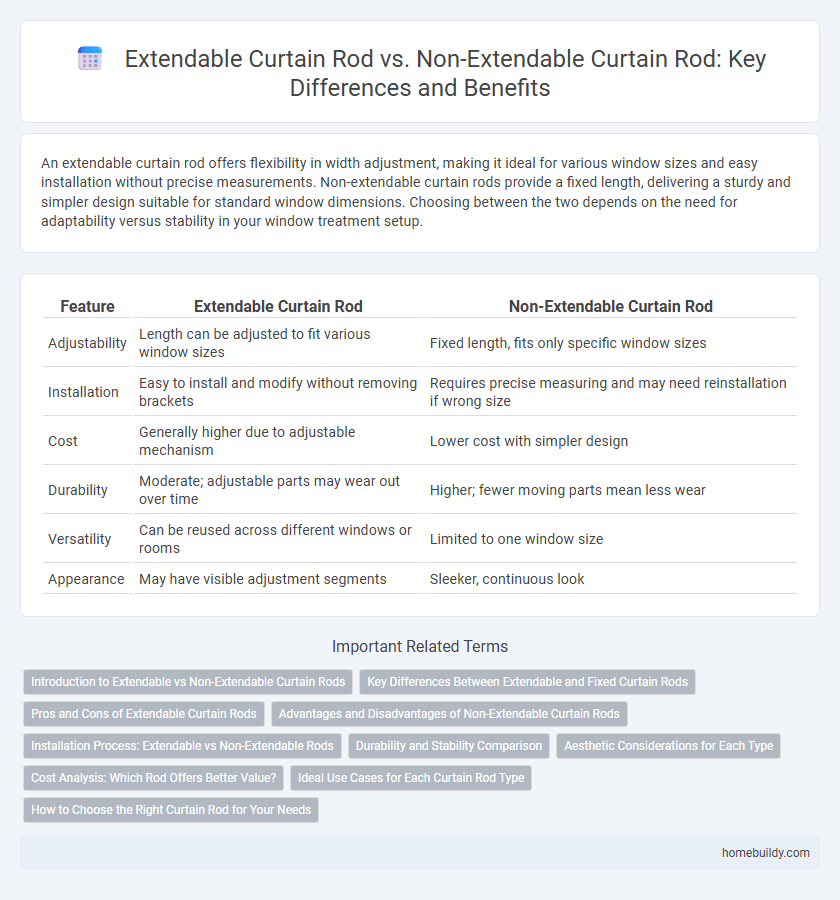An extendable curtain rod offers flexibility in width adjustment, making it ideal for various window sizes and easy installation without precise measurements. Non-extendable curtain rods provide a fixed length, delivering a sturdy and simpler design suitable for standard window dimensions. Choosing between the two depends on the need for adaptability versus stability in your window treatment setup.
Table of Comparison
| Feature | Extendable Curtain Rod | Non-Extendable Curtain Rod |
|---|---|---|
| Adjustability | Length can be adjusted to fit various window sizes | Fixed length, fits only specific window sizes |
| Installation | Easy to install and modify without removing brackets | Requires precise measuring and may need reinstallation if wrong size |
| Cost | Generally higher due to adjustable mechanism | Lower cost with simpler design |
| Durability | Moderate; adjustable parts may wear out over time | Higher; fewer moving parts mean less wear |
| Versatility | Can be reused across different windows or rooms | Limited to one window size |
| Appearance | May have visible adjustment segments | Sleeker, continuous look |
Introduction to Extendable vs Non-Extendable Curtain Rods
Extendable curtain rods offer adjustable lengths, providing flexibility for various window sizes and easy customization during installation. Non-extendable curtain rods come in fixed lengths, typically providing greater sturdiness and a cleaner, more minimalistic appearance. Choosing between extendable and non-extendable rods depends on factors like window dimensions, desired aesthetic, and installation preferences.
Key Differences Between Extendable and Fixed Curtain Rods
Extendable curtain rods offer adjustable lengths, providing flexibility for various window sizes and reducing the need for precise measurements, while fixed curtain rods come in set lengths that require exact window dimensions for installation. Extendable rods typically include telescoping mechanisms that ease the installation process and allow for easy adjustments, whereas non-extendable rods are simpler in design but less versatile for resizing or repositioning. Durability may vary, with fixed rods often being sturdier due to their one-piece construction, whereas extendable rods might have slight compromises in stability due to their adjustable components.
Pros and Cons of Extendable Curtain Rods
Extendable curtain rods offer flexible sizing, making them ideal for windows of varying widths without the need for custom measurements. They simplify installation and allow easy adjustments but may lack the sturdiness of non-extendable rods, potentially sagging under heavy curtains. The telescoping design can also result in visible seams that affect aesthetic appeal compared to solid, fixed-length rods.
Advantages and Disadvantages of Non-Extendable Curtain Rods
Non-extendable curtain rods provide a sturdy and streamlined design ideal for fixed window measurements, ensuring maximum support for heavier curtains without the risk of slipping or sagging. Their solid construction reduces installation complexity, offering enhanced durability but limiting flexibility when resizing or relocating the rod. The primary disadvantage lies in the lack of adjustability, which can result in the need for precise measurements and potential replacement if window dimensions change.
Installation Process: Extendable vs Non-Extendable Rods
Extendable curtain rods offer a simpler installation process as they can be adjusted to fit various window widths without precise measurements, reducing the need for additional hardware. Non-extendable rods require accurate measurement and often custom sizing, leading to a more time-consuming installation that may involve cutting the rod to fit. Choosing an extendable rod enhances flexibility and ease during mounting, especially for irregular or changing window dimensions.
Durability and Stability Comparison
Extendable curtain rods offer adjustable lengths but may compromise durability and stability due to additional joints and moving parts prone to wear over time. Non-extendable curtain rods, crafted from a single solid piece, typically provide superior strength and long-term stability, minimizing the risk of sagging or loosening under heavy curtains. For heavy-duty applications, a non-extendable rod with high-quality materials like steel or solid wood ensures consistent support and longevity.
Aesthetic Considerations for Each Type
Extendable curtain rods offer flexible length adjustment, allowing seamless integration with various window sizes and enhancing overall room aesthetics by minimizing visible hardware gaps. Non-extendable curtain rods provide a clean, solid look with uniform structure, ideal for spaces where precise rod length is predetermined and stability is prioritized. The choice affects visual harmony, with extendable rods blending adaptability and sleekness, while non-extendable rods emphasize consistency and durability in design.
Cost Analysis: Which Rod Offers Better Value?
Extendable curtain rods typically cost more upfront than non-extendable rods due to their adjustable design and versatility, offering savings on installation and the ability to fit various window sizes without replacement. Non-extendable rods tend to be less expensive initially but may require purchasing multiple sizes for different windows, increasing overall expenses. When analyzing cost over time, extendable rods provide better value by combining flexibility with fewer replacements and lower labor costs.
Ideal Use Cases for Each Curtain Rod Type
Extendable curtain rods offer versatility for adjustable window sizes and irregular spaces, making them ideal for renters or rooms with varying window dimensions. Non-extendable curtain rods provide sturdier support for heavy drapes and are best suited for fixed window sizes where durability is a priority. Choosing between these types depends on the need for flexibility versus permanent, reliable installation.
How to Choose the Right Curtain Rod for Your Needs
Extendable curtain rods offer flexibility in width, making them ideal for windows with irregular or varying sizes, while non-extendable rods provide a more sturdy and stable option for standard window dimensions. When choosing the right curtain rod, consider the window measurement accuracy, weight of the curtains, and desired adjustability; extendable rods are best for versatility, and fixed rods suit permanent installations. Material durability and mounting hardware compatibility also impact the choice, ensuring both functionality and aesthetic appeal.
Extendable curtain rod vs Non-extendable curtain rod Infographic

 homebuildy.com
homebuildy.com